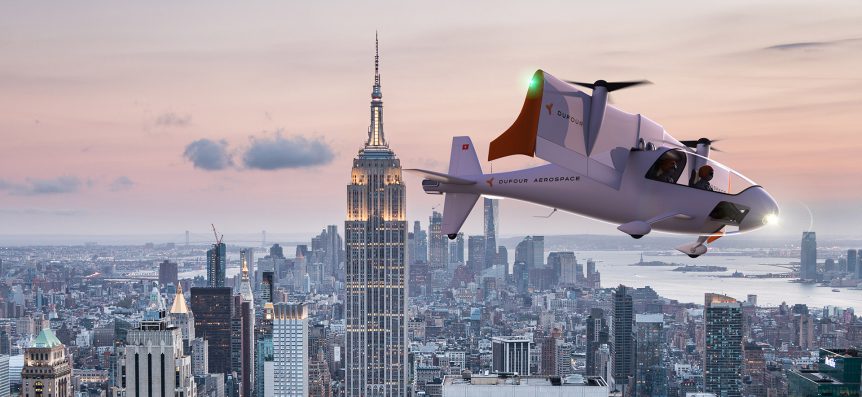Elektroweltrekordflug A team in Switzerland attempted an elektroweltrekordflug, an electric world record flight, hoping to set seven world records in one 700-kilometer trip. Flying a new, certified Pipistrel Velis, the team of Marco Buholzer and co-pilot Morell Westermann hoped to find their way into the Guinness Book of World Records for the following: • Lowest energy consumption (kWh / 100 km -62 miles) over 700km (434 miles) • Highest average speed over 700 km (km / h) • Highest flight altitude ever reached with an electric aircraft (meters – 3.280 feet – above main sea level) • Fastest climbing performance from 0-1000m / 1000-2000m / 2000-3000m (m / s) • Fastest average speed over 100km (km / h) • Smallest number of intermediate stops over a distance of 700 km (number of stops)` • Longest electrically flown route in 24/48/56 hours (km) The team made much the same point that Gabriel DeVault made in accepting the MacCready Prize at last …
Swiss Movements – aEro 1 and aEro 2
Electric Flying Inspires Bigger Plans Dufour Aerospace, based in Visp, Switzerland, and within sight of the Matterhorn, has been flying aEro 1, a Silence Twister-based electric aerobatic craft, for the last two years. Read the pilot report on the surprising performance and the quiet flight experience in the aEro 1 to get some idea of how future flight will be a welcome relief from the noisy today’s noisy passage. “Electric motors are so incredibly efficient. They have a huge torque and you will take off much faster than with regular engines. Our aEro 1 takes off after 70 meters of runway – at 2/3 of the available power. “The first real takeoff and flight afterwards was really mindblowing. I set the power, took off, and checked the instruments, especially the engine instruments. And checked the engine instruments again. You hear the slow roll down of the tires as they stop turning. (Have you ever heard that in a powered aircraft?) …
The Proof is in the Piloting
Helicopter flying has been compared to patting your stomach while rubbing your head, something few manage well, if at all. Imagine trying to not only keep the rudder pedals, cyclic and collective under control but also fiddling with 18 throttles. Even a conventional helicopter is a handful with one engine or motor. Maintaining level flight with multiple lifting points at different points around the central fuselage would add to that level of difficulty beyond most people’s mental processing levels. Luckily, someone at Volocopter has worked out a very clever and quick-witted set of algorithms to take the stress out of that high-risk conundrum, as proven by company CEO Alex Zosel’s recent flight – single-handed and even briefly hands-off. Heike Blödorn, the firm’s public relations spokesperson, writes, “Alex Zosel is thrilled after his first flight and explained that ‘for years, we have claimed that the Volocopter is super easy to fly, now we’ve proven it in a very impressive way. I …
EAS IX: Phil Barnes Double Header
Phil Barnes, aviation consultant, opened each days’ sessions at this year’s Electric Aircraft Symposium: on Friday with a talk on dynamic soaring as taught by the birds, and on Saturday on regenerative power to keep a dynamic soaring aircraft in perpetual flight without any outside energy source other than the sun. Phil has 31-years of experience in the performance analysis and computer modeling of aerospace vehicles and subsystems at Northrop Grumman. He has been to Antarctica twice to photograph and study the flight dynamics of the Albatross, lessons he applies to the ideals of dynamic soaring and energy retrieval in flight. His Friday morning talk, “How Flies the Albatross,” discussed the flight mechanics of dynamic soaring, that mode of maintaining or gaining altitude from horizontal wind gusts, something the albatross uses to fly huge distances searching for food for itself and its family. From the observations of well-known naturalists, he showed the bird “could soar against strong winds without a …
The Future is Electric, and Attracting Attention
FlightGlobal.com, the online version of Flight International Magazine, has an overview of the electric aircraft scene in its April 6, 2010 release. Among the many producers and proponents of electric flight noted in the article, Dr. Brien Seeley of the CAFE Foundation is quoted extensively, as is Calin Gologan of PC-Aero in Germany, both to present at the fourth annual Electric Aircraft Symposium, at Rohnert Park, California on April 23 and 24. The article ponders the hopes of two hybrid electric aircraft powerplant developers, George Bye, featured in a February 21 entry in this blog, and Flight Design’s Oliver Reinhardt, the firm’s technical director. Both face the issue of retrofitting existing light planes with their new engines, and the challenge of obtaining supplemental type certification for such modifications. Highlighted is the 2011 Green Flight Challenge, in which an airplane achieving 200 seat miles per gallon at 100 mph (or an alternative energy equivalent mileage) can earn the CAFE Foundation’s $1.5 …



